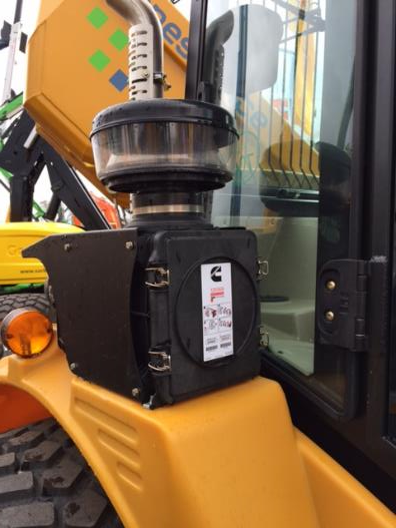During busy times, we know the last thing you want to worry about is your fuel bill. That’s why we’ve generated some helpful hints and tips to help boost fuel efficiency and save you money.
-
Healthy engine = better fuel economy. Engine maintenance is key – maintain and replace your air intake filters in line with the manufacturer’s recommendations and service intervals.

Cummins Filtration Direct Flow Air Intake System
In simple terms, the engine needs an abundance of air to convert the fuel into useful power. Any significant restrictions will cause increased smoke that the particulate filter must catch, a loss of power at the crankshaft and increased fuel consumption. Blowing out an air filter with an air line can cause dirt particles to accumulate on the clean side of the filter and is not recommended. Allowing unfiltered air to enter the engine increases wear to the turbocharger and cylinder bores, which will not only reduce component life but also lead to reduced combustion efficiency and increased fuel consumption.
-
Minimize time spent at idle.
Unnecessary idling should be avoided. Switching the engine off when possible will reduce wasted fuel and help you save money.
During prolonged periods of idling the engine’s aftertreatment system temperature reduces. When this happens, the engine actively raises the catalyst temperature in the aftertreatment in order to maintain efficiency and emissions compliance. This process requires additional fuel. Extended times spent at idle can also have a negative impact on the engine and aftertreatment life.
-
Operator driving style can have a significant effect on fuel consumption. Fast acceleration may not be possible in a tractor pulling a heavy load but when the trailer is empty or only partly loaded reducing acceleration will ultimately result in less fuel being used.

Advancements in transmission controls mean that many modern tractors can automatically select the right gear ratio to carry out field work at the optimum engine speed for fuel efficiency. For less advanced models, the fuel trip computer can be used to help the operator select the gear that maximizes the area covered while using the least amount of fuel.
Most modern tractors have Eco PTO modes that allow the engine speed to be reduced while supporting the optimum operating speed for an attached implement. Eco modes are designed to place the engine at a more efficient operating point when back up torque is required. This produces the same output as the standard mode, but with less fuel burned per horsepower of power.
It may not be possible to use these modes in every case, but is worth trying as it may save money and also reduce noise in the cab at the same time.
-
Get your tire pressure right. Low tire pressure will increase fuel usage, but remember when operating in a muddy environment, low tire pressure helps to increase traction and reduce wheel slip, which will actually reduce wasted fuel. Many tractors are now fitted with tools like tire pressure control systems and electro-hydraulic linkage controls to assist in generating traction and keeping wheel slip at the optimum level.

-
Keep radiators and radiator screens clean. This will avoid any excess fan-on times and reduce the energy consumed by fan operation. Variable speed fans depend on the temperature of the air passing through the cooling pack. If any of the cooling fins of the radiator pack are blocked then this will result in higher system temperatures and an increase in the power required by the cooling fan to cool the engine, hydraulics and auxiliary systems. This is excess power that could otherwise have been used to carry out the task in hand.
Additionally, any blockage in the charge air cooler can have a significant impact on engine power and fuel consumption. Engine horsepower falls about 1% for each 10 degrees of intake air temperature rise above 32 C (89.6 F). As an example, an engine rated at 250hp / 186kW will develop only 240hp / 178kW when the intake air temperature is 54 C (129.2 F) for the same fuel delivery.
-
Be mindful of excess weight. Using ballast in the field to achieve better weight distribution and traction will reduce fuel consumption overall but avoid carrying excess weight when hauling loads at higher speeds. Simple steps like removing wheel weights when not needed and filling your fuel tank with only the fuel you need can make all the difference.
-
Axle oil, rear axle oil and hydraulic oils should all be checked to ensure they are in-line with the manufacturer’s maintenance requirements and topped up where necessary.
-
Use the right equipment for the job. Using appropriately sized equipment will help reduce your fuel bill. High power output and low weight should be key factors when selecting suitable equipment for road haulage. If a tractor is primarily used for field cultivations, then opperational weight and peak torque output will be the main factors to consider. There is often overlap between model power outputs, so decisions may affect fuel economy when in use.
-
Use diff-lock and 4WD appropriately. If these features aren’t used correctly, it can cause drag or excess wheel slip. Your tractor may have automatic settings to assist in using these features properly.
- Make use of your vehicle’s features. Tools such as headland management, guidance systems via GPS and field mapping could not only help increase your yield but also can have a positive impact on fuel consumption. GPS guidance systems reduce the amount of overlapping and a precision of 2 centimeters can be reached when using autosteer with GPS data and a correction signal like RTK. If we use a system like this for intensive work, such as plowing or tillage, where the engine runs at near full load during the whole operation, reducing overlap can reduce the amount of fuel used. This could lead to a considerable saving.
Cummins Performance Series
"Performance has a name"
Since our first engine for agriculture was manufactured in 1919, Cummins has powered equipment for some of the world’s leading manufacturers. Around 1 million Cummins engines are in operation around the world in combine harvesters, tractors, sprayers and specialist autonomous equipment.
From 2.8 to 19 liters, Cummins engines are tailored for farm performance, helping you get the job done even in the most challenging environments. Our worldwide service network covers more than 190 countries across 6 continents – we’re there for you, wherever you are.
For more information visit cummins.com.







